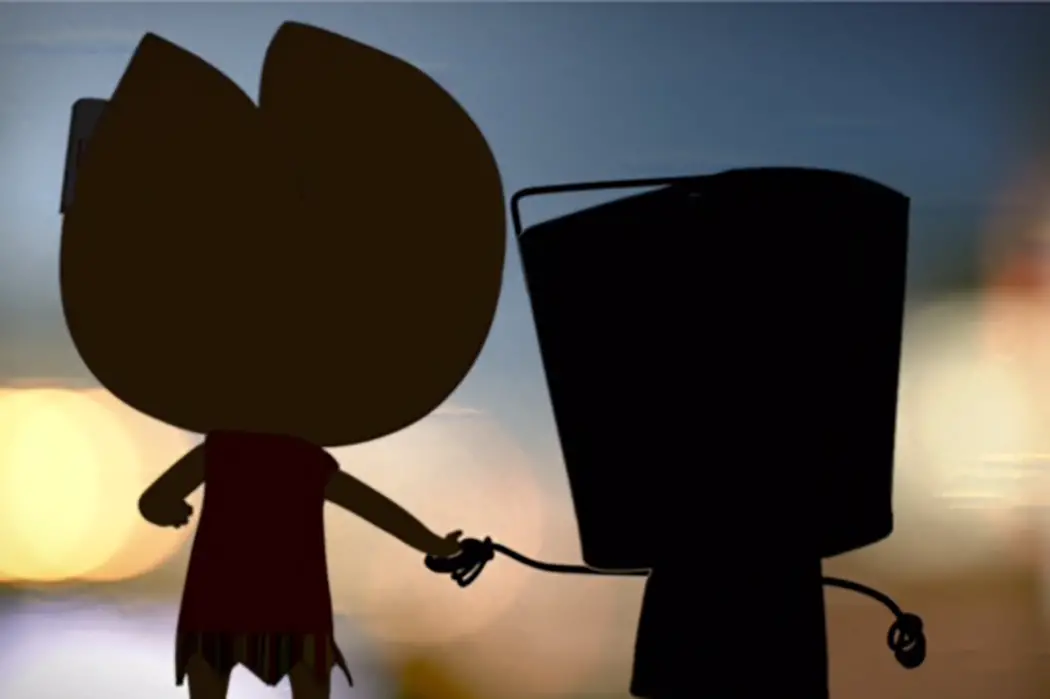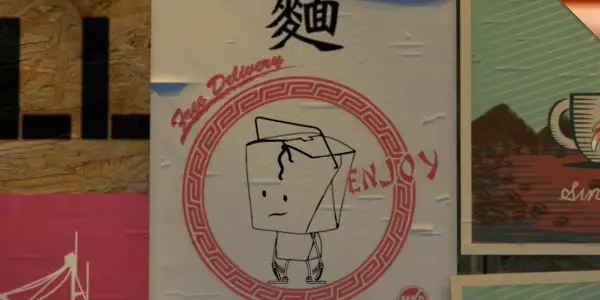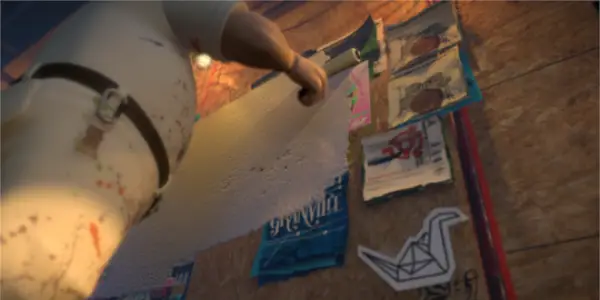POST NO BILLS: A Cute Animated Short (+ Interview With Director Robin Hays)

Stephanie Archer is 39 year old film fanatic living in…
There is something about animated short films – the shortened length of time drawing you in and locking your attention in place. At just under 5-minutes, Post No Bills does just that. With a soft and gentle beginning, Post No Bills wastes no time creating tension and excitement. It is an endearing journey of a Chinese take-out carton saving the cookie of his dreams. With its video game-esque concept, it breaks free of its short film boundaries, leaving you wanting more.
Please Post More
Post No Bills is a short animated film I did not want to end. While the initial survival and pairing up of Noodle Boy and Miss Fortune was neatly resolved at the end of the film, I wanted more. I wanted to see where these two would go, what happens after. The tension the film and its soundtrack created ebbed as the film reached its satisfying conclusion, but it wasn’t enough. This would be a short film that could animate the minds of children and full length features.
Beginning with an evening coffee, Noodle Boy chills calmly with his neighboring rooster, dreaming of the cookie down the way. Life is but a dream, peaceful and quiet. This is all abruptly extinguished the moment a white van pulls alongside the wall of bills, a man and his paint can on a mission to wipe the wall clear. Knowing himself and Ms. Fortune are facing obliteration, Noodle Boy risks it all to save his love.
Post No Complaints
Post No Bills was an animated short film executed to perfection – one that will be a favorite of mine for some time. Every element of art and filmmaking cohesively melded together, the amalgamation of talent behind the scenes delivering one stunning film. Led by the talented writer and director Robin Hays, Chinese food is given a whole new life, level of cuteness and relatability.
The score from Post No Bills is incredible, transitioning perfectly based on the poster the character is in. The music that accompanies the worker and his paint curler is dramatic, helping to build tension as the Chinese takeout runs away, just narrowly missing a white out fate. Noodle Boy’s journey is accompanied by a variety of scores, each poster he is in creating an opportunity for new challenges and achievements for him to face. The tension each score and transition builds is perfectly timed and paced.
The animation is exquisite, mimicking and reminiscent of a Pixar short animated film. I was extremely impressed to find out this was Hays‘ first animated short – a risk that seems to have found its way into the meaning of the short film itself. Her decisions extended farther than just direction and taking risks. The choice of simplistic noises for the characters instead of dialogue is brilliant, allowing the animation and score to speak for itself. There is a breath of freshness within the film that dialogue would have smothered, each talent within the film having a moment to shine.
A Memorable Message
The message of the short – “the biggest risk is not taking one” (which is cleverly a fortune within the cookie) – is easily seen through the actions of Noodle Boy, and the final actions of both him and Miss Fortune. She was a motivating factor for him to risk it all to save her, and together they found the strength to take the biggest risk of all. This risk would allow them to break barriers and enter a new world.

The message, however, is not limited to the short. It transcends the risk taken by the Chinese takeout and is applicable to the risk of the filmmaker and ourselves in our daily lives. Originally a live-action filmmaker, Robin Hays took the risk to make this film. Filmmakers and artists take risks everyday, the products of their efforts satisfying varieties of groups and individuals. Many of their successes would have never been achieved if risks hadn’t been taken.
It is also applicable to our everyday lives. At one time or another, we have all faced a decision, a risk. Whether or not we take that risk can spell out the future of our lives and further decisions. It is important to remember in our everyday lives that by being afraid to take a risk, we may never achieve our full potential. Post No Bills delivers the entertainment and tension, but it ends with a message that we can all take to heart everyday.
Interview
I was delighted and excited to have an opportunity to interview Robin Hays, the writer and director of Post No Bills. Since 2017, her short animated film has been circulating the festival scenes and has been well received worldwide. During our interview, we discussed this endearing short, the process that went into making it and even took a moment to look at the road ahead.
Stephanie Archer for Film Inquiry: Thank you so much for speaking with me today and congratulations on your short and film festival success.
Robin Hays: No, thank you very much. And thank you for speaking with me as well.
The animated shorts are definitely one of my favorites, so I really appreciate you sharing your short film with me.
Robin Hays: I’m glad you like it.
Your first short film Bug Hutch was a live action, as will be your upcoming film Anthem. What drove your decision to make Post No Bills an animated film?
Robin Hays: Right. So my background is actually in live action. I’ve been working in live action a very long time, with mainly the commercial director. I’ve done a few shorts and produced some live actions. I actually came up with a concept for Post No Bills about 10 years ago and I pitched it to my friend Andy Poon, Andy, who is an amazing artist and art director. And when I pitched this to him, he quickly sketched a very rudimentary design of Noodle Boy, like 10 years ago.
And being from live action, I was really hesitant to try animation. I’ve always loved animation, but I thought it would be too difficult, so we just kind of let the idea sit. But Andy kept reminding me over the years like, “well, why don’t we try and bring Noodle Boy to life, I think there is something there”. So long story short, 10 years later I finally listened to him and we brought it to life. So it was really me facing my own fears of venturing into animation and trying it out and it turns out that I love it, so much.
What was the inspiration behind the concept of the story of Post No Bills?
Robin Hays: I came up the concept when I was in New York. So I loved street art and I’m always looking at things when I’m walking around. I’m just looking at the posters and I had that idea of that childhood concept of toys coming to life when you’re not looking. So it’s that concept applied to posters. I just thought it would be something that we can have a lot of fun with.

That definitely reflects in the film itself, especially when he gets to the disco part – a lot of fun. How was it directing an animated film different from directing a live action short?
Robin Hays: That was probably the most surprising thing to me. I thought it would be very, very different, but it turns out it actually wasn’t. For me, for both live action and animated film, I like to supply as much reference as possible. So often, for example, with live action, I’ll photograph a toy, let those become my storyboards. It was the same with animation. What I did is I actually created a whole cardboard set of Post No Bills. And then I filmed and photographed and created kind of like my own animatic before the storyboards, just to give everybody an idea of what we’re doing. So the whole film exists in a very funny format with all the cardboard.
That’s a really great idea. Besides the absence of dialogue, what were some of the differences in writing the film’s script for animation versus live action?
Robin Hays: What I think was really great about it was the fact that the possibilities are endless with animation, like our main character, the Noodle Boy is trying to rescue a fortune cookie, so that’s really fun about animation. That there are so many possibilities you can’t really do in live action.
But yeah, that was a really great point. We decided not to have any dialogue, that was a very conscious decision. I’m trying to make sure that we have a beginning, middle and end and are creating an emotional connection with viewers in under five minutes is a challenge regardless of whether it’s live action or animation. So, that was probably the biggest challenge is just making sure that you’ve created characters who were interesting and had an arc within a short period of time.
That’s awesome. The animation and the score of a Post No Bills is phenomenal. Very catching and engaging. What was the process like culminating such a successful creative team?
Robin Hays: I’m so fortunate. I feel very, very lucky to be able to collaborate with so many amazing people to help bring this film to life. Obviously because we didn’t have that dialogue, the score was very, very important. It’s always really important, but in this case it was imperative that we were able to use the score to help us portray as the emotion that we wanted with the character. So Andrew Harris is the composer on the film and he did a phenomenal job with it. And he’s somebody that I’ve known for a very long time and have worked with on multiple projects. So as soon as we started bringing the project to life, we started speaking with Andrew and just going back and forth as to how we wanted the score to sound.
It was a really good score. And why did you choose Chinese takeout as your main character’s – Noodle Boy and Miss Fortune?
Robin Hays: Well, it was always Noodle Boy because I just loved the design of take-out boxes and I thought it could be really cute. And originally when I thought of it, as he was running, I always saw like noodles falling out and little peas falling out. That didn’t end up making it into the final film. I just thought it could be something really cute.
So when I pitched this to Andy and then he started the design, we’re like, “Oh yeah, we think there is something, there is just a lot of possibilities with it. It could be something that was cute”. That was the main thing cuteness, I guess. And then with Miss Fortune, she actually was something different, so she wasn’t a fortune cookie to begin with. There were a few different designs that we went through. But at the end of the day we decided on the fortune cookie, which is quite a challenge to make a fortune cookie look cute. The lines and the design, they’re not the best. So Andy did a phenomenal job with both characters.

I definitely liked Miss Fortune, she’s very exuberant, very happy. It came off very cute. Was there any personal meaning in the film’s takeaway message in the end – “the biggest risk is not taking one”?
Robin Hays: There is, yeah, actually, and it’s for me because it goes back to the concept that I came up with this idea 10-years ago and I just kind of put it in the drawer and sat on it because I thought animation would be too difficult to create and because I knew nothing about it. So, when I took the risk and was like, “okay, well I’ll learn as I go and we’ll try this out and see if you like it”. I took a risk and I didn’t know how it would pan out. I’m very, very grateful that I did because if I didn’t take my own fears and try something that I hadn’t done before, Post No Bills wouldn’t exist and would not be having this conversation right now. I hope that when people see the film it inspires them to do something that’s a little bit afraid to try.
Post No Bills has been circulating the festival scene since last year. How has it been seeing and hearing audience reactions and how, if any, has it been different from your previous short films?
Robin Hays: It’s been really fun to see the film and to have a positive response, especially with kids. Well, I shouldn’t say with kids. It’s really fun to see that the film, people are responding to it regardless of age and regardless of whatever country they’re from, it’s screening in countries all over the world and people of all ages really are responding to it. So whenever you create something with a film, or any type of art, and you release it, you don’t know how people are going to respond to it. So to have this positive response is really, really nice. I think with kids, there was one little girl at a festival and she came up to me after the film, she was about four or five. She said, “Robin, I really liked your film, but when you got up and you were talking, that was a bit boring”. [laughs] She was a cutie, I was like “Awesome. I appreciate that”. [laughs]
[laughs] You have an upcoming film you produced and directed called Anthem. Anything you can tell us about that?
Robin Hays: It’s my first feature film. It’s a project that was brought to me, so I wasn’t involved in the script. It’s the first project that I’ve done where it isn’t my own material. I learned a lot, it was fantastic working with the actors.
Oh, that’s awesome. I look forward to seeing it! Well, those are all the questions that I have for today. I really thank you for taking the time to speak with me.
Robin Hays: Thank you very much. I’m glad you enjoyed the film.
Film Inquiry thanks Robin Hays for speaking with us!
Does content like this matter to you?
Become a Member and support film journalism. Unlock access to all of Film Inquiry`s great articles. Join a community of like-minded readers who are passionate about cinema - get access to our private members Network, give back to independent filmmakers, and more.













